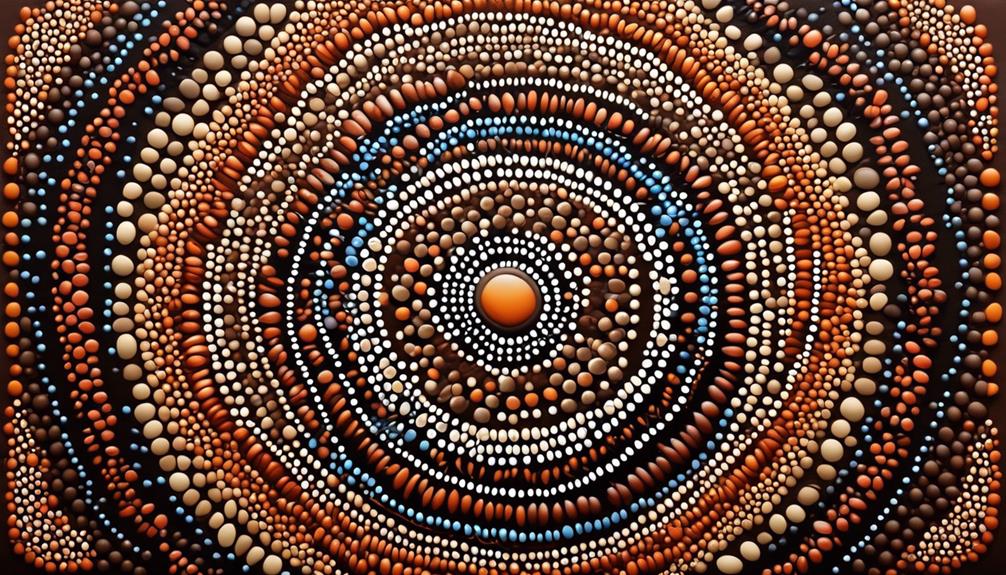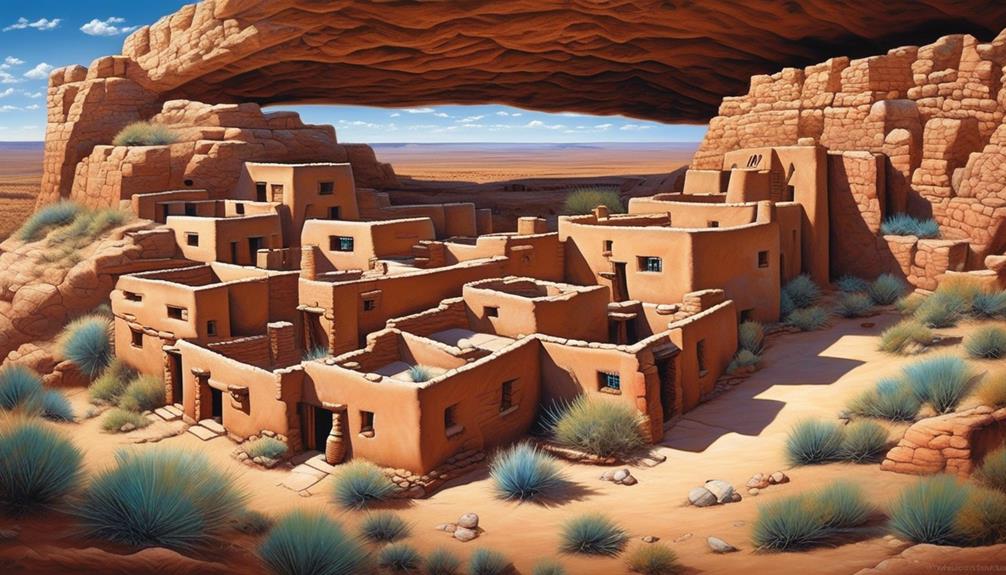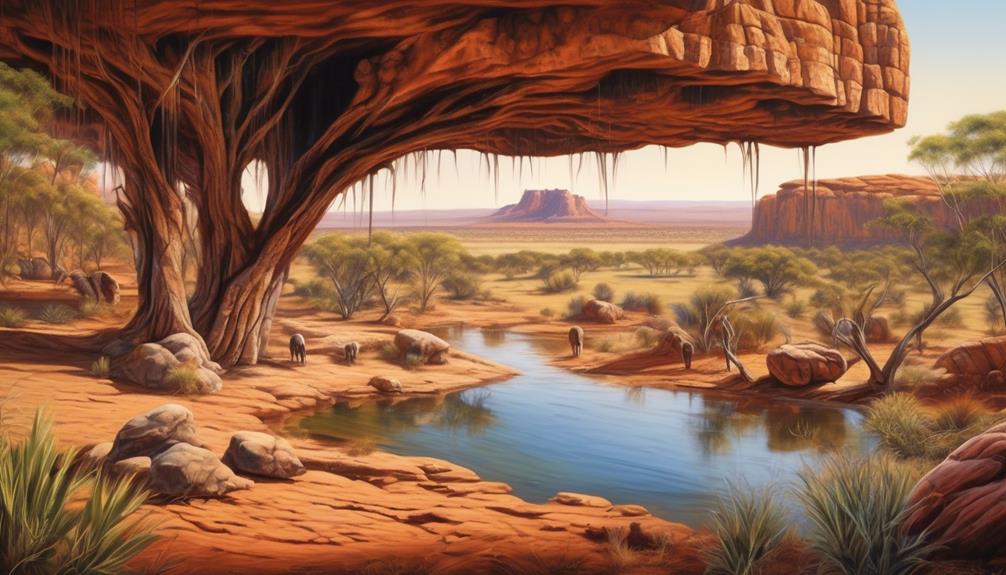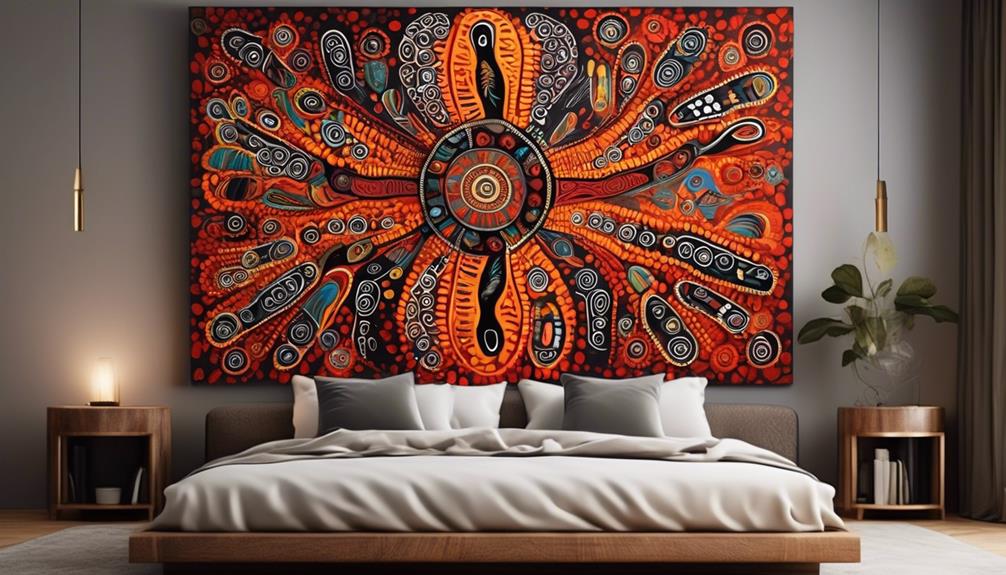Aboriginal art delves deeper than its outward appearance. It is packed with symbolism and narratives that may not be readily apparent, making it a distinctive and profound form of artistic communication. The detailed patterns and traditional methods employed lend Aboriginal art a captivating complexity and beauty that is truly mesmerizing.
So, if you've ever been curious about how to incorporate this art form into your own creative endeavors or simply want to learn more about its history and significance, you're in the right place. Aboriginal art may seem complex at first glance, but with a few key insights and tips, you'll be well on your way to understanding and even creating your own Aboriginal-inspired art.
Key Takeaways
- Aboriginal art symbols communicate ancient stories, traditions, and spiritual beliefs.
- Traditional techniques like dot painting, cross-hatching, and rarrk are used in Aboriginal art.
- Incorporating Aboriginal art enhances cultural representation and storytelling through visual expression.
- Respect for the cultural significance of symbols, motifs, and colors is essential when creating Aboriginal-inspired art.
Understanding Aboriginal Art Symbols
Understanding Aboriginal art symbols provides insight into the rich cultural heritage and spiritual significance of the indigenous Australian peoples. Aboriginal art isn't merely a form of decoration; it's a means of communicating ancient stories, traditions, and spiritual beliefs. The symbols used in Aboriginal art hold deep cultural significance, often representing elements of the natural world, ancestral beings, and sacred rituals. Each symbol carries a specific meaning that's passed down through generations, serving as a visual language that connects the Aboriginal people to their heritage and land.
The cultural significance of Aboriginal art can't be overstated. It serves as a vital link to the past, offering a window into the traditions and beliefs of Australia's first inhabitants. By understanding the meanings behind the symbols, one gains a deeper appreciation for the complexity and depth of Aboriginal culture. Moreover, it fosters a greater respect for the spiritual connection that the Aboriginal people have with their ancestral lands.
In essence, delving into the world of Aboriginal art symbols is a journey of understanding, respect, and enlightenment.
Exploring Traditional Aboriginal Art Techniques
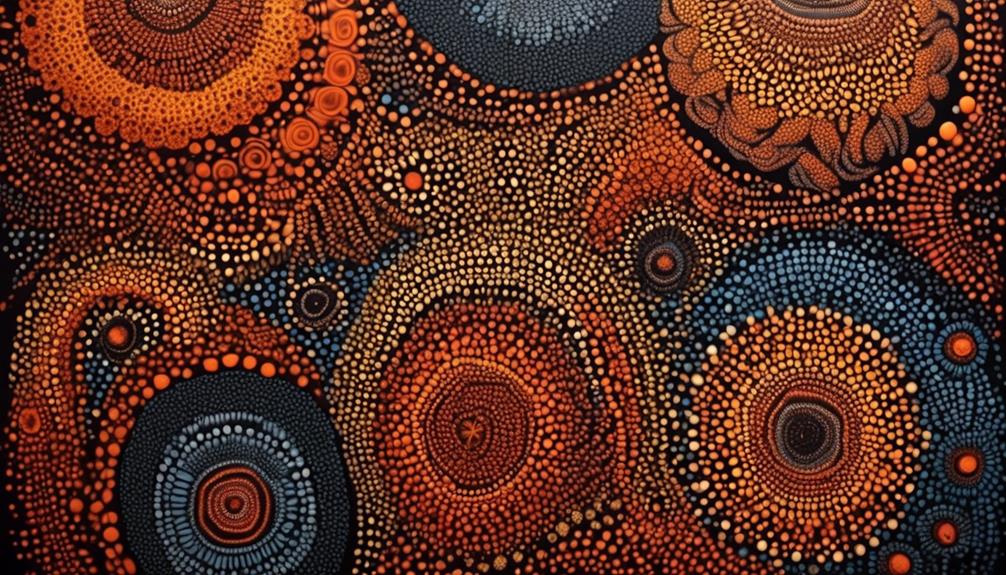
The cultural significance of Aboriginal art symbols is further illuminated through the exploration of traditional Aboriginal art techniques. Understanding these techniques provides insight into the deep-rooted traditions and stories of the Aboriginal culture. Traditional techniques such as dot painting, cross-hatching, and rarrk are integral to the creation of Aboriginal art, each holding its own cultural significance.
| Traditional Technique | Description | Cultural Significance |
|---|---|---|
| Dot Painting | Involves creating intricate patterns using dots. | Symbolizes landmarks, sacred sites, or connection to the land. |
| Cross-Hatching | Utilizes intersecting lines to fill in shapes or create texture. | Represents the relationship between people, the land, and ancestral spirits. |
| Rarrk | Involves fine and elaborate cross-hatching patterns. | Depicts ceremonial body paint designs and totemic symbols.
These techniques not only showcase the artistic skill of the Aboriginal people but also serve as a means of passing down cultural knowledge and preserving their heritage. By delving into traditional Aboriginal art techniques, one gains a deeper appreciation for the cultural significance and storytelling aspects embedded in each stroke and pattern.
Incorporating Aboriginal Art Into Your Designs
Incorporating Aboriginal art into design projects can enhance cultural representation and offer a unique perspective on storytelling through visual expression. Artistic interpretation plays a pivotal role in integrating Aboriginal art into designs. It involves understanding the cultural significance behind the symbols, patterns, and colors used in traditional Aboriginal art. This understanding allows for the respectful and authentic incorporation of these elements into various design mediums, such as textiles, graphics, and architecture.
When integrating Aboriginal art into designs, it's essential to consider the cultural significance of specific motifs and symbols. For instance, the use of certain animal symbols might hold particular meaning within Aboriginal culture, and incorporating them thoughtfully can add depth and authenticity to the design. Additionally, colors also carry cultural significance and can be used to convey specific messages or evoke certain emotions within the design.
Moreover, the process of incorporating Aboriginal art into designs should always involve collaboration and consultation with Aboriginal artists and communities. This ensures that the representation is respectful and accurate, while also fostering a deeper understanding of the cultural narratives and traditions embedded within the art. By approaching the incorporation of Aboriginal art with sensitivity and understanding, designers can create meaningful and culturally rich designs that honor and celebrate Aboriginal heritage.
Tips for Creating Aboriginal-Inspired Art
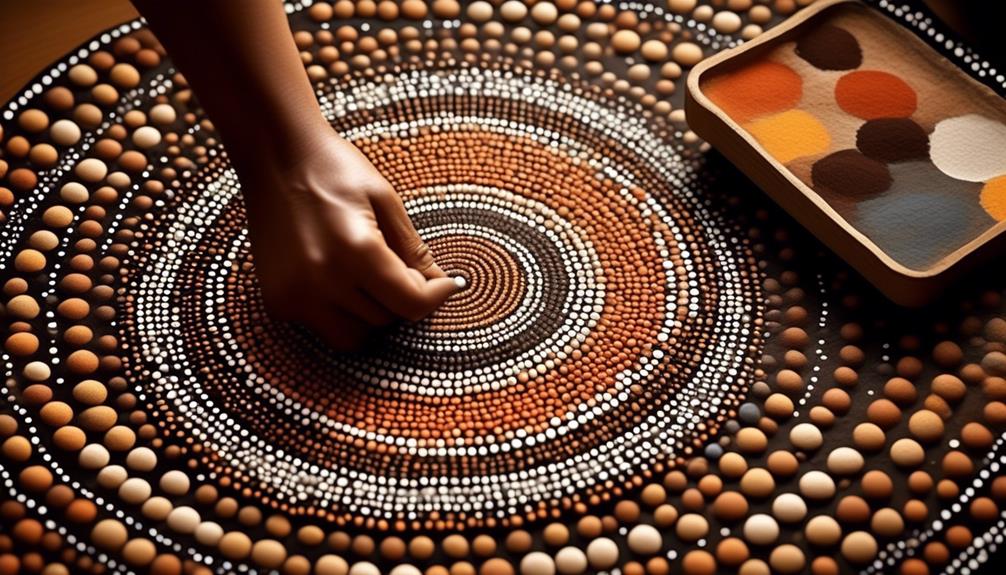
When creating Aboriginal-inspired art, it's important to approach the process with a deep respect for the cultural significance of symbols, motifs, and colors within traditional Aboriginal art. Understanding the symbolism behind colors is crucial. For example, yellow represents the sun, warmth, and knowledge, while red symbolizes the earth and spiritual matters. Incorporating these color meanings into your artwork can add depth and authenticity to your Aboriginal-inspired pieces.
Additionally, mastering dot painting techniques is essential. This traditional method involves using fine dots to create intricate patterns and designs. Each dot holds significance and often represents elements of nature, stories, or ceremonies. Understanding the technique and practicing precision is key to achieving the beautiful and meaningful aesthetic of Aboriginal dot paintings.
Lastly, studying the traditional motifs and symbols used in Aboriginal art is crucial. Each symbol carries deep cultural and spiritual meanings, and it's important to use them thoughtfully and respectfully in your artwork. By learning about the meanings behind these symbols, you can infuse your art with the rich storytelling and cultural heritage inherent in Aboriginal art.
Showcasing Your Aboriginal Art作
Showcasing Aboriginal art in a culturally sensitive and respectful manner is essential for honoring its significance and heritage. When promoting Aboriginal art, it's crucial to celebrate and preserve indigenous culture while ensuring that the artwork is presented in a manner that respects the traditions and stories behind it.
One effective way to showcase Aboriginal art is by collaborating with Indigenous artists and communities. This not only provides a platform for the artists to share their work but also fosters a deeper understanding of the cultural significance of the art.
Additionally, utilizing traditional venues such as art galleries and cultural centers can provide a respectful space for the promotion of Aboriginal art. It's also important to acknowledge the importance of proper attribution and compensation for the artists whose work is being showcased.
Furthermore, leveraging digital platforms and social media can help reach a wider audience, but it's essential to do so in a way that respects the cultural context of the art.
Frequently Asked Questions
How Can I Respectfully Engage With Aboriginal Art and Culture as a Non-Indigenous Person?
Responsible appreciation of Aboriginal art and culture as non-indigenous individuals involves ongoing cultural education and respectful engagement.
We strive to acknowledge the significance and history of these artistic traditions, recognizing the diversity and complexity within them.
It's crucial to approach this with humility and open-mindedness, seeking to understand rather than appropriate.
Are There Any Specific Restrictions or Guidelines I Should Be Aware of When Using Aboriginal Art in My Designs or Artwork?
When using Aboriginal art in our designs or artwork, it's crucial to be mindful of potential cultural appropriation. We should ensure that our representation of Indigenous cultures is respectful and ethical.
It's important to engage with Aboriginal art in a way that honors its cultural significance and respects the rights of Indigenous communities. By being aware of specific restrictions and guidelines, we can contribute to a more inclusive and respectful artistic landscape.
What Are Some Common Misconceptions About Aboriginal Art That I Should Be Aware Of?
Some common misconceptions about Aboriginal art that we should be aware of include misunderstanding the symbols and meanings behind the artwork.
It's important to have an awareness of appropriation and to approach Aboriginal art with respect and understanding.
Can You Recommend Any Resources or Organizations That Support and Promote Aboriginal Artists and Their Work?
Sure, we recommend exploring the Indigenous Art Code, an organization that promotes fair and ethical trade in the art market and supports Indigenous artists.
Additionally, the Australian Indigenous Art Trade Association is a valuable resource for understanding the art market and supporting artist recognition.
It's important to be mindful of cultural appropriation and seek out organizations that prioritize Indigenous support and cultural integrity in the art community.
How Can I Learn More About the Cultural Significance and Stories Behind Specific Aboriginal Art Symbols and Techniques?
We can explore the cultural significance and stories behind specific Aboriginal art symbols and techniques by seeking an Indigenous perspective and delving into art interpretation.
Engaging in cultural education allows for in-depth symbolism exploration, providing insights into the rich heritage and traditions embedded in the artwork.
This approach fosters a deeper appreciation and understanding of the narratives and meaning behind each unique Aboriginal art form.
Conclusion
In conclusion, incorporating Aboriginal art into your designs can add a unique cultural perspective and aesthetic appeal.
Did you know that the Aboriginal art market is worth over $200 million annually, making it one of the most valuable art markets in the world?
By understanding the symbols and techniques of traditional Aboriginal art, you can create beautiful and meaningful pieces that honor the rich cultural heritage of Australia's Indigenous peoples.
